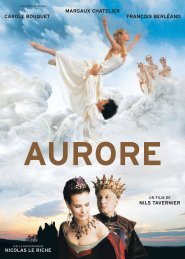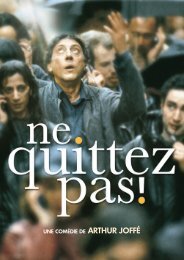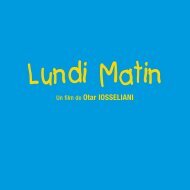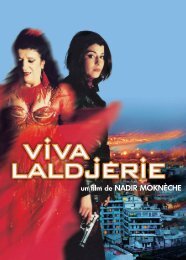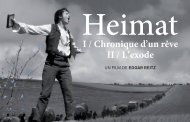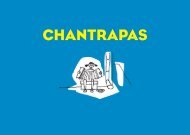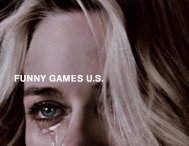NORMANDY - Les Films du Losange
NORMANDY - Les Films du Losange
NORMANDY - Les Films du Losange
You also want an ePaper? Increase the reach of your titles
YUMPU automatically turns print PDFs into web optimized ePapers that Google loves.
A FILM BY<br />
BACK TO<br />
<strong>NORMANDY</strong><br />
NICOLAS PHILIBERT
<strong>Les</strong> <strong>Films</strong> d'Ici & Maïa <strong>Films</strong> present<br />
BACK TO<br />
<strong>NORMANDY</strong><br />
A film by Nicolas Philibert<br />
Running time: 113 minutes<br />
2006 • Format: 35 mm / 1:85 • Sound: Dolby SRD • Visa n°112 199<br />
Press kit and photos can be downloaded from the following site www.retourennormandie-lefilm.com<br />
International Sales<br />
<strong>Les</strong> <strong>Films</strong> <strong>du</strong> <strong>Losange</strong><br />
Daniela Elstner • Agathe Valentin • Lise Zipci<br />
22, av. Pierre 1er de Serbie - 75016 Paris<br />
Tel. +33 1 44 43 87 24 / 28 / 13 • Fax. +33 1 49 52 06 40<br />
in Cannes :<br />
Riviera Booth L5<br />
Tel. : +33 4 92 99 33 35<br />
International Press<br />
Alibi Communications / Brigitta Portier<br />
Unifrance / Club Unifrance<br />
Village international Pantiero<br />
Tel. : +33 4 93 99 86 18<br />
in Cannes :<br />
Portable: +33 6 29 60 75 41 or +33 6 79 12 07 93<br />
brigittaportier@hotmail.com or alibi-com@skynet.be
«<br />
SYNOPSIS<br />
This film's origins lie in another.<br />
The one that the director René Allio shot in Normandy in<br />
1975 based on a local crime: I, Pierre Rivière, Having<br />
Slaughtered My Mother, My Sister and My Brother…<br />
I was 24 at the time. René Allio had offered me a position<br />
as first assistant director.<br />
Shot a few miles from the scene of the triple murder 140<br />
years earlier, this film owed most of its uniqueness to the<br />
fact that nearly every part was given to local country people.<br />
Today, I have decided to return to Normandy to seek out<br />
the transient actors of the film.<br />
Thirty years have passed…<br />
«<br />
Joseph Leportier<br />
3
INTERVIEW WITH<br />
NICOLAS PHILIBERT<br />
/ Before you were hired to work on Moi, Pierre Rivière… what<br />
had your previous experience been?<br />
My very first professional experience was as a trainee on <strong>Les</strong><br />
Camisards, also directed by René Allio, in the summer of 1970. I<br />
was in my first year at university in Grenoble at the time. I was 19<br />
and I dreamt of “being in movies” without really knowing in what<br />
capacity. In early July, I heard that a film was going to be shot in the<br />
Cévennes. With a friend, I hitchhiked down to Florac. Two days<br />
later, when we turned up at the pro<strong>du</strong>ction office, we were told that<br />
they were only taking trainees from among local people to avoid<br />
paying for hotel rooms. So we lied, said that we were locals and it<br />
worked! Over three months, I was, in turn, a messenger for the set<br />
crew, an assistant grip, an assistant prop man and an extra. Then I<br />
went back to Grenoble and returned to my studies but, two years<br />
later, I decided to move to Paris. René Allio - again - was preparing<br />
a new film, Rude journée pour la Reine, for which I was hired as an<br />
assistant set designer, in charge of props. I didn't know much about<br />
the job but I got by somehow. The following year, I worked with<br />
Alain Tanner, Claude Goretta, and then the experience of Moi,<br />
Pierre Rivière… came along.<br />
/ Why was this film so important for you?<br />
Firstly, I didn't have much experience as an assistant and, all of<br />
a sudden, I found myself entrusted with a huge responsibility: the<br />
screenplay indicated that it would be a complex shoot with a large<br />
number of characters, children, animals, numerous sets, costumes…<br />
and a very tight budget. And the decision to entrust the main<br />
roles, at least the roles of peasants - the murderer, his family, the<br />
neighbours, the witnesses - to local farmers and their families<br />
rather than to professional actors gave the whole undertaking a unique<br />
human dimension. We had to travel the countryside looking for<br />
our characters, overcome the scepticism with which they greeted<br />
the project, make it credible in their eyes and so enrol them in an<br />
adventure that they were not at all prepared for. With Gérard<br />
Mordillat - the other assistant director - I thus spent almost three<br />
months, going from farm to farm, from country fairs to union meetings<br />
5
with the professional actors who rounded out the cast. As a result,<br />
in the group that we formed, we never had the feeling of a division<br />
between the film crew and the country people. We all had our own<br />
part to play to bring the same project to fruition. Later, looking<br />
back, I realized just how lucky I had been to take part in this exceptional<br />
experience, totally unique in French cinema. The film has<br />
stayed with me over the years. It has perhaps even irrigated my<br />
own work, like an underground “riviere” (river). Probably because<br />
fiction and documentary were so closely interlinked in it.<br />
Charles et Annie Lihou<br />
to find the actors and to share our conviction with them. It was a<br />
fascinating experience but a difficult and uncomfortable one, especially<br />
when you realize that three weeks away from the planned<br />
shooting date, we still didn't know if the film would be made or not<br />
since money was so short. And then the shoot, after several delays,<br />
finally started and, in spite of the financial difficulties that weighed<br />
down on it until the end, this shared experience between film people,<br />
nearly all of them Parisians, and Normandy country folk was a<br />
very powerful one. The shooting conditions were tough, the weather<br />
unreliable, the days long and trying, but I think that everyone<br />
who participated in this adventure had the feeling that they were<br />
experiencing something exceptional. The film set itself apart from<br />
the usual representation of the rural world in the cinema that is<br />
often mocking or scornful. We were also a long way from any<br />
condescending approach. Allio was just as demanding with his<br />
country actors and had as much faith in their abilities as he was<br />
/ Over the years that followed, did you stay in touch with the<br />
actors of Allio's film?<br />
One year after shooting Moi, Pierre Rivière... some of us went<br />
back to Normandy to present the film. But, after that, we lost touch<br />
and I didn't see them again, except for Claude Hébert, who played<br />
Pierre Rivière. He continued to work as an actor for a few years. He<br />
was living in Paris and I would often meet him at Allio's place. Then<br />
in the middle of the 1980s, Claude left Paris for good and I never<br />
saw him again either. Then, in the spring of 2000, before I started<br />
filming Etre et Avoir, I went back to Normandy where I saw Joseph<br />
and Roger. It was a friendly reunion and, in the back of my mind, I<br />
started thinking about a film with them all.<br />
/ When did you decide to start work on this project and how did<br />
they react?<br />
At the end of 2004, the Fémis (Cinema and Audiovisual professional<br />
school) invited me to present a film of my choice to its students.<br />
I chose Rivière. None of them had seen it. Most of then hadn't even<br />
heard of Allio, less than ten years after his death. That made my blood<br />
6<br />
Roger Peschet
un cold. After the screening, instead of having the usual debate, I<br />
read texts to them for an hour: notes made by Allio about his film,<br />
extracts from his “diaries”… They discovered a filmmaker, an unusual<br />
and fascinating body of work and they were stunned. I went<br />
home and I decided to make this film. For the last thirty years, I have<br />
kept a few photos and documents from Rivière: the shooting<br />
sche<strong>du</strong>le, my copy of the screenplay… It all started<br />
from there. In early January, I hopped on a train<br />
to Caen, rented a car and started calling on everyone.<br />
It was very moving! The memories left by<br />
the experience were incredibly vibrant. Each<br />
participant had turned the page, undertaken all<br />
kinds of things, had lived happy times and less<br />
happy ones, but they all spoke about this<br />
experience with an intense feeling of gratitude.<br />
A few weeks later, when I first mentioned the<br />
idea of making a film with them, they had no<br />
better idea than I did what it would be like but they<br />
trusted me. They had followed my work, knew some<br />
of my films and had remained intensely loyal to Allio and<br />
his crew, recalling each member clearly.<br />
/ When the project started to come together, what were the<br />
choices that guided your work?<br />
From the very beginning, it was obvious that this would be a film<br />
narrated in the first person, with its roots in my own memories, and<br />
that I would intervene through a voice-over. At the same time, I<br />
wanted to make a film set firmly in the present, not a filmed pilgrimage.<br />
And finally, in relation to my previous films that nearly all focused<br />
on a single setting, I wanted a more fragmented and freer form this<br />
time in which it would be possible to slip from one register to another,<br />
at times from one period to another, with a as much fluidity as<br />
possible. I imagined that there would be a common core - Allio's<br />
film - giving rise to a multitude of characters, stories, settings, and<br />
sequences of varying nature: voice-over, interviews,<br />
documents, extracts, direct cinema sequences, landscapes…<br />
But everything was fairly vague and it<br />
wasn't until shooting and then editing that this<br />
tree-like structure asserted itself.<br />
/ You often talk about your penchant for a<br />
portion of improvisation. How does that<br />
work in this film?<br />
From that point of view, Back to Normandy<br />
follows my usual approach. The ideas came<br />
along <strong>du</strong>ring filming and, apart from certain places<br />
like the prison, the courthouse or the<br />
Calvados archives were we could only film on specific<br />
dates, the shoot was mostly improvised, according<br />
to encounters and conversations. In general, I don't like to<br />
prepare things too much. If everything is mapped out ahead of<br />
time, you miss out on the essential. There has to be an element of<br />
the unknown. The fact of having to invent the film day after day, to<br />
seek it out until the very end, procures a <strong>du</strong>al feeling of freedom and<br />
fragility that stimulates me and drives me into a corner. During editing,<br />
it's the same. I had 60 hours of rushes, in other words virtually<br />
tens or hundreds of combinations. And yet, at the end of the day,<br />
there's only one film possible: the one you carry deep within you.<br />
Annick Bisson<br />
9
However, I continually avoided the pitfall of making a film for film<br />
buffs or an audience already aware of the original story. It has to<br />
speak to everyone. If you haven't seen Allio's film or ever heard<br />
about the Rivière case, that doesn't matter. This story has an almost<br />
timeless dimension and could have taken place anywhere: a long<br />
time ago, somewhere in the country, a film was shot about a<br />
crime, with non-professional actors. Since then, life has<br />
gone on, but not exactly the same as before…<br />
/ The film is constructed in such a way that<br />
we never know what the next shot will<br />
show…<br />
That's a result of its fragmentary nature, the<br />
diversity of registers and the materials used.<br />
Since the film tells several stories in parallel,<br />
they echo each other, mingle and mutually<br />
enrich each other. The relationship between<br />
them is explicit at times and less obvious at<br />
others. From this point of view, my use of extracts<br />
from Moi, Pierre Rivière… is significant. They burst in<br />
when we least expect them since I never summon them<br />
up to illustrate an interview. Each time we switch from my footage<br />
to Allio's, the transition takes place on a sensory level: it occurs<br />
according to a fictional, almost dream-like logic, as if Pierre Rivière's<br />
appearances were there to irradiate the rest. As we progress<br />
through the film, we realize that it is like a layer cake made up of different<br />
superimposed strata, linked between each other. Deep<br />
down, I wanted to work on a sort of paradox: the evocation of Allio's<br />
shoot had to be central to my film but it could not be an end unto<br />
itself. It had to echo other questions. About the cinema, about our<br />
world, about our relationships with others, with our fathers…<br />
/ This fragmentation allows you to pass from one theme to another<br />
as if the film were progressing through associations of<br />
ideas…<br />
The film gra<strong>du</strong>ally leaves the straightjacket that a<br />
documentary is usually constrained in: its subject. It<br />
is marked out by encounters and sequences that<br />
lead us off in other directions… I'm thinking of<br />
Annie and Charles who talk about their daughter's<br />
illness; about Nicole, the former militant<br />
who had the bakery in Athis, and about her<br />
struggle since her accident to recover the<br />
power of speech; about Joseph, who still<br />
makes his own cider; about the workers at the<br />
Éclair labs; about the prison in Caen, where<br />
Pierre Rivière ended up hanging himself, etc.<br />
With such a multitude of elements, it's hard to<br />
hem in the film. Present and past, memory, madness,<br />
writing, speech, illness, lurking death, passing<br />
time, the law, transmission… The film concerns all those<br />
things and many others that are not cleaved together. As in real life,<br />
where the intense and the insignificant frequent each other at all<br />
times. But this is first and foremost a film that talks about the<br />
cinema, from the angle of desire, obstinacy and its capacity to build<br />
bridges and forge bonds. Most of the interviews evoke this collective<br />
dimension since the film returns to a shared experience of<br />
cinema. We realize that, for them too, the shooting of Allio's film was<br />
10<br />
Claude Hébert<br />
as Pierre Rivière
a decisive and even fundamental experience, just as it was for me.<br />
Both because it brought together people who wouldn't have met<br />
otherwise and also because it raised us up somehow.<br />
/ Your voice-over narration describes the preparations for<br />
Allio's film at length but you say hardly anything about the<br />
shoot itself…<br />
I felt that it was more interesting to talk about the problems that we<br />
had encountered and, beyond this example, of the obstinacy that<br />
all filmmakers have to show to reach their goals, whenever their<br />
projects display artistic ambition and stray from the beaten track.<br />
The gap between rich and poor films, that has continued to grow<br />
wider in recent years, already existed thirty years ago. I worked on<br />
four occasions with René Allio and I always saw him deploy incredible<br />
energy in order to make his films and pay off his debts. The<br />
general public usually only sees the glamorous side of the cinema,<br />
as if that's all there were to see! I wanted to lift a corner of the veil.<br />
The sequence shot at the Éclair labs also shows the other side of<br />
the story: the chemical in<strong>du</strong>stry, the violence of the market, the<br />
pension funds and these people who work for set hours, with<br />
breaks, like on a pro<strong>du</strong>ction line…<br />
Gilbert Peschet<br />
cinema comes from! Michel Philibert, René Allio… Since we're dealing<br />
with the question of filiation here, I should add that the music<br />
used in the film is partly by a young French jazzman, Jean-Philippe<br />
Viret, and partly by André Veil, an in<strong>du</strong>strialist from Lorraine and an<br />
amateur composer whom, as a child, I would listen to for hours in<br />
the evening as he composed at his piano. He was my maternal<br />
grandfather.<br />
/ The final sequence remains very discreet. We don't learn anything<br />
about your father…<br />
My father was a professor of philosophy and loved the cinema.<br />
Alongside his university lectures, he would give a weekly “public<br />
class in the cinematic art” in front of a crowded lecture hall in which<br />
he would screen and analyze films by Bergman, Dreyer, Antonioni,<br />
Bresson, etc. There's no need to tell you where my love of the<br />
La famille Borel<br />
13
CREW<br />
Direction Nicolas Philibert • Photography Katell Djian • Camera<br />
Nicolas Philibert, Katell Djian • Sound Yolande Decarsin • Editing<br />
Nicolas Philibert assisted by Thaddée Bertrand • Mix Julien<br />
Cloquet • Camera assistants Justine Bourgade, Nicolas Duchêne,<br />
Benjamin Serero • With the occasional participations of François<br />
Belzeaux, Bertrand Boudaud, Jordane Chouzenoux, Sofiane El<br />
Fani, Jean-Gildas Guéran, Christophe Leraie, Christophe<br />
Lussignol, Magali Pacher, Cécile Philibert, Olivier Schwob,<br />
Andra Tevy, Dominique Vieillard • Pro<strong>du</strong>ction management David<br />
Berdah, Tatiana Bouchain, Katya Laraison • Post-pro<strong>du</strong>ction<br />
coordination Sophie Vermersch • Executive pro<strong>du</strong>cers Serge Lalou<br />
et Gilles Sandoz • Co-pro<strong>du</strong>cers <strong>Les</strong> <strong>Films</strong> d'Ici/Serge Lalou -<br />
Maïa <strong>Films</strong>/Gilles Sandoz - ARTE France Cinéma / Michel<br />
Reilhac, Thierry Garrel and Rémi Burah • With the backing of<br />
Canal +, TPS STAR, the Centre National de la Cinématographie<br />
and France Télévisions Distribution • In partnership with<br />
Soficinéma • With the support of Région Basse-Normandie and<br />
the collaboration of la Maison de l'Image Basse-Normandie<br />
Distribution & International Sales <strong>Les</strong> <strong>Films</strong> <strong>du</strong> <strong>Losange</strong>.<br />
Music « Elégie » (André Veil) performed by Gaëlle Pavie, piano /<br />
recording Jean-Marc Laisné, Amati • « Espoir » et « Volonté » (André<br />
Veil) performed by Alice Ader, piano and Alexandre Brussilovsky,<br />
violin / recording and mix Ludovic Palabaud, Acousti studios<br />
« Trois jours de trêve » and « Sablier » (Jean-Philippe Viret), by<br />
Jean-Philippe Viret, double bass, Edouard Ferlet, piano and<br />
Antoine Banville, drums, album Étant donnés (P) Sketch (E)<br />
Mélisse, album L'indicible (P) Atlante pro<strong>du</strong>ctions • « Le nucléaire<br />
on n'en veut pas » (Achille Lorentz) and « Sors ton pied de cette<br />
m… » performed by the Stop Bure Brothers n'Sista • Additional<br />
original music Jean-Philippe Viret (E) 2006 Mélisse, performed by<br />
Edouard Ferlet, piano, and Jean-Philippe Viret, double bass /<br />
recording and mix Sylvain Thévenard.<br />
With extracts from « Moi, Pierre Rivière ayant égorgé ma mère,<br />
ma sœur et mon frère … » directed by René Allio, based on the<br />
collective work edited by Michel Foucault • With the kind permission<br />
of Pascal Bonitzer, Jean Jourdheuil, Serge Toubiana, Paul<br />
Allio, Pierre Allio, Roland Rappaport, Francine Fruchaud, Denis<br />
Foucault and the participation of the SFPC and the INA • Photo<br />
credits Paul Allio, Corinne Atlas, Philippe Barrier, Gérard<br />
Mordillat, Jean-Denis Robert, <strong>Les</strong> Pro<strong>du</strong>ctions de la Guéville,<br />
Sabine Strosser.<br />
Film stock Kodak • Camera equipment <strong>Les</strong> <strong>Films</strong> d'Ici, Iris Caméra<br />
and <strong>Les</strong> Poissons Volants • Sound equipment DC Audiovisuel •<br />
Editing facilities <strong>Les</strong> <strong>Films</strong> d'Ici and Pom'Zed • Mix Archipel<br />
Pro<strong>du</strong>ctions and SIS • Optical transfer Ciné Stéréo • Titles<br />
Ercidan • Insurance Diot Bellan • Laboratoires Eclair Didier<br />
Dekeyzer, Thierry Gazaud, Daniel Langenfeld, Catherine Athon,<br />
Ronald Boullet, Philippe Tourret, Emmanuel Chex, Nicolas<br />
Criqui, Régis Oyer, Christophe Boutigny, Laurence Vidot<br />
Timing Raymond Terrentin.<br />
14
WITH<br />
In order of appearance Joseph and Marie-Louise Leportier<br />
Nicole Picard • Gilbert and Blandine Peschet • Annick and Michel<br />
Bisson • Jacqueline Millère • Anne, Catherine, Christophe,<br />
Olivier, Pierre and Yvonne Borel • Norbert Delozier • Charles and<br />
Annie Lihou • Roger Peschet and Caroline Itasse • Janine Callu<br />
Nicole Cornué • Bruno Gahéry • Claude Hébert.<br />
And Alain Bazin, Pierre Ducreux, Gül Kütükcü, Aline Leprévost,<br />
Jean Mican, Patrick Poulain, Fabienne Requeut, Stéphane<br />
Rogue, Alain Carel, Anthony Delalande, Michèle Belfleur<br />
Legeai, Simone Soubien, Viviane Thébault, Mohamed<br />
Hamidèche, Annie Lemée, Muriel Lemmel, Jocelyne Liebmann,<br />
Gilles Martin, Cyril Roussin, Béatrice Roy, Liliane Gallon,<br />
Valérie Poirier, David Boisgontier, Jean Peschet and Raymond<br />
Pringault.<br />
Thanks to Christian Goret, François Callu, Julien, Romain and<br />
Rémi Bisson, Laurence, Daniel and Raymond Hébert, Christelle,<br />
Mathias et Emmanuel Peschet, Dominique Gonet, Franck Pillot,<br />
Aline Fromont, Loïc Gautier, Christine Hubert, Maxime Sannier,<br />
Marguerite and Jacques Devalpinçon, Jean-Noël and Marie-<br />
Odile Chapelle, David Nevoux et Sonia Pouchard, Colombe and<br />
Guy Mongodin, Monique and Michel Feron, Madeleine and<br />
René Géhan, Thérèse and Albert Husnot, Gérard Jambin, Elie<br />
Alizon.<br />
Marie Archambault, Philippe Charrier, Olivier Corpet, Alain<br />
Desmeulles, Julie Le Mer, Sandrine Samson, Eliane Vernouillet -<br />
Institut Mémoires de l'Edition Contemporaine • Isabelle Homer,<br />
Jean-Marc Lebeurrier, Louis Le Roc'h Morgere - Archives<br />
départementales <strong>du</strong> Calvados • Dominique Blondel, Céline Caroff,<br />
Jean-Christophe Castaings, Olivier Lefèvre and the whole staff<br />
at the Faurecia factory in Flers • François Chevailler, Pascal<br />
Moyon and Patrick Wardenski - Centre Pénitentiaire de Caen<br />
Hélène Michelot, Guy Frémy - Tribunal de Grande Instance de<br />
Caen.<br />
<strong>Les</strong> Editions Gallimard • La Cinémathèque française • SETE - Éclairages<br />
Pierre Bideau • Isabelle Truffault - Festival Granit • Françoise<br />
Plouviet, Frédéric Valay • Hôtel Le Galiond • Cinéma <strong>Les</strong> 4 Vikings<br />
Alain Jublan and Deen Touré - Football Club de Flers • Gilles<br />
Asselot and the staff of <strong>Les</strong> Andouilles Asselot • The restaurants<br />
Au bout de la rue, Berverl'Inn, Saint-Germain and Le Carneillais.<br />
Linda De Zitter, Christine Laurent, Laura Briand, Céline Païni,<br />
Frédéric Cheret, Catherine Roux, Christophe Besnard, Ophélie<br />
Lerouge, Monique Assouline, Michelange Quay, Nathalie<br />
Bloch-Lainé, Sandra Mirimanoff, Laurent Hassid, Valéry<br />
Gaillard, Roland Rappaport, Judith Schor, Marie Quinton, Denis<br />
Fruchaud, Philippe Barrier, Corinne Atlas, Jacques Doillon,<br />
Pascal Kané, René Féret, Gérard Mordillat, Régine Vial, Daniela<br />
Elstner, Sophie and Romain Goupil, Alain and Stéphanie Weill,<br />
Jean-Paul Commin, Isabelle Le Guern, Thierry Garrel, Daniel<br />
Defert, Janine Philibert, Cécile et Bastien, Annette Guillaumin,<br />
Stéphane Lemolleton.<br />
Norbert Delozier<br />
17
NICOLAS PHILIBERT<br />
FILMOGRAPHY<br />
Nicolas Philibert first worked as a trainee on <strong>Les</strong> Camisards,<br />
by René Allio (1970), as props man on Rude journée pour la Reine<br />
(1973), as assistant director on Moi, Pierre Rivière… (1975) and as<br />
line pro<strong>du</strong>cer on L'Heure exquise (1981) all directed by René Allio.<br />
He has also worked with Alain Tanner (Le Milieu <strong>du</strong> monde, 1974),<br />
Claude Goretta (Pas si méchant que ça, 1974) and Joris Ivens<br />
(Une Histoire de vent, 1986).<br />
Retour en Normandie (Back to Normandy) - 2007 (113 mn)<br />
L'Invisible - 2002 (45 mn) • Être et avoir (To Be and to Have) -<br />
2002 (104 mn) • Qui sait ? (Who Knows ?) - 1999 (106 mn) • La Moindre<br />
des choses (Every Little Thing) - 1997 (105 mn) • Un animal,<br />
des animaux (Animals) - 1996 (59 mn) • Portraits de famille<br />
(Family Portraits) 1995 (3 mn) • Le Pays des sourds (In the Land<br />
of the Deaf) - 1993 (99 mn) • La Ville Louvre (Louvre city) - 1990<br />
(84 mn) • Migraine 1989 (6 mn) • Le Come back de Baquet<br />
(Baquet's Come Back) - 1988 (24 mn) • Vas-y Lapébie ! (Go For<br />
It, Lapébie!) - 1988 (27 mn) • Trilogie pour un homme seul<br />
(Trilogy for One man) - 1987 (53 mn) • Y’a pas d’malaise (No Problem)<br />
- 1986 (13 mn) • Christophe - 1985 (28 mn) • La Face nord<br />
<strong>du</strong> camembert (The North Face of the Camembert) - 1985 (7 mn)<br />
Patrons / Télévision (Bosses / Television) - 1979 (3 X 52 mn, codirected<br />
with Gérard Mordillat) • La Voix de son maître (His<br />
Master's Voice) - 1978 (100 mn, co-directed with Gérard Mordillat).<br />
19
I, PIERRE RIVIÈRE,<br />
HAVING SLAUGHTERED<br />
MY MOTHER, MY SISTER<br />
AND MY BROTHER...<br />
Format 1,66 - 16 mm blown up to 35 mm - Running time 130<br />
minutes - French theatrical release Octobre 27, 1976.<br />
Directed by René Allio.<br />
Co-pro<strong>du</strong>ced by <strong>Les</strong> <strong>Films</strong> Arquebuse, Polsim Pro<strong>du</strong>ction,<br />
Société Française de Pro<strong>du</strong>ction, Institut National de<br />
l’Audiovisuel.<br />
Collaboration on the screenplay Pascal Bonitzer, Jean Jourdheuil,<br />
Serge Toubiana, based on the collective work edited by Michel<br />
Foucault.<br />
Photography Nurith Aviv • Sound Pierre Gamet • Editing Sylvie<br />
Blanc • Assistant direction, shoot preparation and casting Gérard<br />
Mordillat, Nicolas Philibert • Script supervisor Marie-Hélène<br />
Quinton • Costumes Christine Laurent • Sets Françoise Darne<br />
Location manager Bernard Bouix • Pro<strong>du</strong>ction manager Michèle<br />
Plaa • Line pro<strong>du</strong>cer René Féret • Distribution PlanFilm.<br />
With Claude Hébert Pierre Rivière • Jacqueline Millière Mother<br />
Joseph Leportier Father • Annick Géhan Aimée • Nicole Géhan<br />
Victoire • Émilie Lihou Paternal grandmother • Antoine Bourseiller<br />
Judge Legrain • Michel Amphoux Clerk of the Court Lebouleux<br />
Jacques Debary Doctor Bouchard • Chilpéric de Boiscuiller<br />
Royal Prosecutor in Vire • Léon Jeangirard Doctor Vastel • Robert<br />
Decaen Maternal grandfather • Marthe Groussard Maternal grandmother<br />
• Monsieur Bisson Paternal grandfather • Roger Harivel<br />
Uncle • Jeanne Bouquerel Dame Hébert • Pierre Borel Drummer<br />
Anne-Marie Davy Widow Quesnel • Gilbert Delacour Lami Binet<br />
Norbert Delozier Nativel • Henri Gahéry Hébert • Albert Husnot<br />
Farmer • Christian Jardin Victor Marie • Victor Lelièvre Fortin<br />
Olivier Perrier Handsome carpenter • Gilbert Peschet Quevillon<br />
Yvonne Peschet Cousin • Bernard Peschet Postel • François<br />
Callu Young Pierre Rivière • Vincent Callu Prosper Rivière • Laurent<br />
Callu Jean Rivière • Myriam Callu Victoire Rivière, 4 • Christophe<br />
Millière Jules Rivière • Pierre Allio Pierre Rivière, 4 • Christophe<br />
Menou Prosper Rivière, 5 • Pierre Leomy Justice of the Peace • Guy<br />
Mongodin Clerk of the Court Langliney • René Féret Doctor Morin<br />
Jean-Bernard Caux Health officer de santé • Charles Lihoux<br />
Mayor of Aunay • Marc Eyraud Father Suriray • Paul Savatier Priest<br />
at Courvaudon • Roland Amstutz Sergeant at Langannerie • Michel<br />
Dubois Judge in Vire • Yves Graffey Judge Foucaud • Roland<br />
Rappaport General prosecutor • Gérard Guérin Presiding judge.<br />
20
RENÉ ALLIO’S<br />
NOTEBOOKS (extracts *)<br />
“When I was a young man and dreamt of being an artist, I saw<br />
myself as a painter. Those whose works I saw, whose biographies<br />
and letters I read were Cézanne, Van Gogh, Gauguin (…)<br />
If I identified with those artists, they didn't prepare me for an<br />
easy life where success and recognition for your work are what<br />
drive you on but rather the struggle, stubbornness above all,<br />
obstinate progress, more often than not alone.”<br />
“Pierre Rivière. We must make a film to express as best as possible,<br />
in other words in artistic and poetic terms, what I write<br />
here or say so often, namely my desire to save from oblivion and<br />
death… those violent, dramatic moments, intense, beautiful<br />
moments of all these lives, of those who cannot speak, who<br />
leave no trace and yet who display skill, imagination, bravery,<br />
invention and love in order to simply exist, to go on existing or<br />
to change or simply to en<strong>du</strong>re.”<br />
“You need to be like couch grass and grow back whenever<br />
you're cut down. Ineradicable. That's it. With my films, I want to<br />
be like couch grass. Be like it for myself when I doubt or lose<br />
heart. The only reaction: one more film, one more fight, one<br />
more surge. Like couch grass, ineradicable.”<br />
* Editions Lieu Commun (1991)<br />
René Allio<br />
23
RENÉ ALLIO<br />
FILMOGRAPHY<br />
His work led him to take a close interest in the problems of modern<br />
theatrical architecture and the transformation of the stage area. He<br />
designed the Théâtre d'Aubervilliers, collaborated on the design of<br />
the future Maison de la Culture in Tunisia, on the project to convert<br />
Arnold Wesker's « Rond House » and on the transformation of the<br />
former Théâtre Sarah Bernhardt in Paris, now called the « Théâtre<br />
de la Ville ».<br />
René Allio was born in Marseille in 1924. He started out<br />
as a painter after studying literature. He showed his<br />
works in Paris between 1957 and 1962.<br />
During the same period, he worked for the stage. First in Paris for<br />
avant-garde theatres, then in the provinces for various Dramatic Art<br />
Centres. In this way, he designed sets and costumes for a number<br />
of plays in the French and foreign repertoire and worked on the first<br />
performances of plays by Adamov, Vauthier, Ionesco, Alberti.<br />
From 1957 on, he worked regularly with Roger Planchon, for several<br />
years on the stage design for all the pro<strong>du</strong>ctions at the Théâtre de<br />
la Cité, with plays by Brecht, Shakespeare, Molière, Racine,<br />
Marivaux, Marlowe, Gogol.<br />
He also worked for the Comédie française, the Paris Opera, the<br />
TNP and the most famous stages in Europe : Scala de Milan, the<br />
Royal Shakespeare Company, the Cologne Opera...<br />
24<br />
He made his cinema debut with an animated film that he designed<br />
for a stage pro<strong>du</strong>ction of Gogol’s « Dead Souls » and continued with<br />
a short film that he shot in 1963. From that point on, until his death<br />
in 1995, he never stopped working for the cinema.<br />
La Meule - 1963 (CM) • La Vieille dame indigne (The Shameless<br />
old lady) - 1965 • L’Une et l’autre (The other one) - 1967 • Pierre<br />
et Paul (Pierre and Paul) - 1968 • <strong>Les</strong> Camisards - 1970 • Rude<br />
journée pour la Reine (Rough day for the Queen) - 1973 • Moi,<br />
Pierre Rivière, ayant égorgé ma mère, ma soeur et mon frère -<br />
1975 • Retour à Marseille - 1980 • L'Heure exquise - 1981 • Le<br />
Matelot 512 - 1984 • Jean Vilar, quarante ans après - 1987 • Un<br />
médecin des Lumières - 1988 • Transit - 1990.<br />
Conception graphique de l’affiche Cécile et Bastien • FB • Imprimerie Gestion Graphic 01 39 95 41 26



